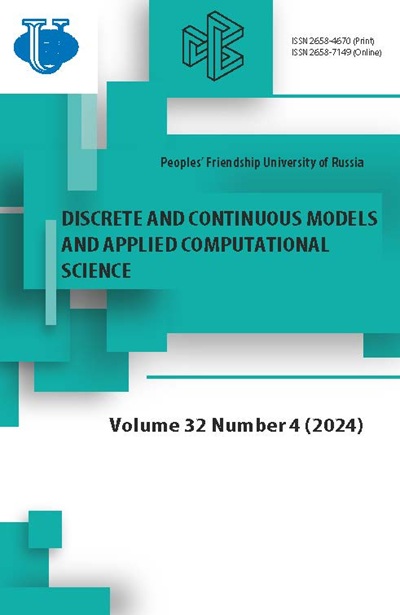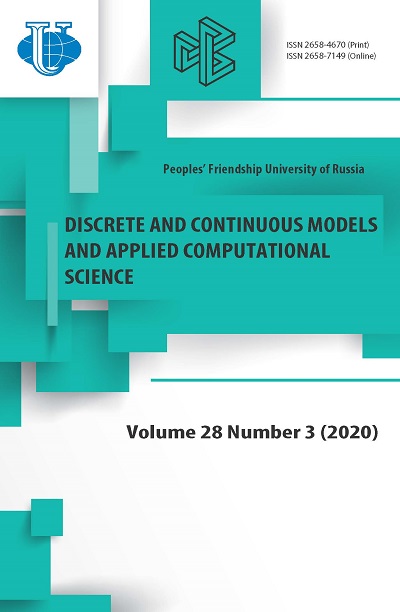Модель квантовых измерений Курышкина-Вудкевича для атомов щелочных металлов
- Авторы: Зорин А.В.1
-
Учреждения:
- Российский университет дружбы народов
- Выпуск: Том 28, № 3 (2020)
- Страницы: 274-288
- Раздел: Статьи
- URL: https://journals.rudn.ru/miph/article/view/24706
- DOI: https://doi.org/10.22363/2658-4670-2020-28-3-274-288
Цитировать
Полный текст
Аннотация
Конструктивная форма модели квантовых измерений Курышкина-Водкевича ранее была подробно разработана для квантовой задачи Кеплера. Для более сложных квантовых объектов такая конструкция неизвестна. В то же время стандартная (неконструктивная) модель квантовых измерений Холево-Хелстрома подходит для любого квантового объекта. В данной работе конструктивная модель квантовых измерений обобщена на более широкий класс квантовых объектов, то есть на оптический спектр атомов и ионов с одним валентным электроном. Анализ основан на экспериментальных данных об энергетическом упорядочении электронов в атоме по правилу Клечковского-Маделунга и на обосновании одночастичной потенциальной модели для описания энергетического спектра оптических электронов в атомах щелочных металлов. Представление возмущения одночастичного потенциала в виде свертки потенциала электрона в атоме водорода с функцией Вигнера некоторого эффективного состояния остова в представлении атома щелочного металла позволяет редуцировать все алгоритмы расчета для щелочных металлов к соответствующим алгоритмам для атома водорода.
Об авторах
А. В. Зорин
Российский университет дружбы народов
Email: zorin-av@rudn.ru
ул. Миклухо-Маклая, д. 6, Москва, 117198, Россия
Список литературы
- A. V. Zorin and L. A. Sevastianov, “Hydrogen-like atom with nonnegative quantum distribution function,” Physics of Atomic Nuclei, no. 70, pp. 792-799, 2007. doi: 10.1134/S1063778807040229.
- L. Sevastyanov, A. Zorin, and A. Gorbachev, “Pseudo-Differential Operators in an Operational Model of the Quantum Measurement of Observables,” in Mathematical Modeling and Computational Science, G. Adam, J. Buša, and M. Hnatič, Eds., vol. 7125, Berlin, Heidelberg: Springer Berlin Heidelberg, 2012, pp. 174-181. doi: 10.1007/978-3- 642-28212-6_17.
- G. M. D’Ariano, U. Leonhardt, and H. Paul, “Homodyne detection of the density matrix of the radiation field,” Phys. Rev. A, vol. 52, R1801-R1804, 1995. doi: 10.1103/PhysRevA.52.R1801.
- G. M. D’Ariano, “Measuring Quantum States,” in Concepts and Advances in Quantum Optics and Spectroscopy of Solids, T. Hakioglu and A. S. Shumovsky, Eds., Amsterdam: Kluwer Acad. Publishers, 1997, pp. 175- 202.
- A. S. Holevo, Statistical Structure of Quantum Theory, ser. Lecture Notes in Physics Monographs. Berlin: Springer, 2001, vol. 67. doi: 10.1007/3-540-44998-1.
- C. W. Helstrom, Quantum Detection and Estimation Theory. New York: Academic Press, 1976.
- G. Ludwig, Attempt of an axiomatic foundation of quantum mechanics and more general theories, II, ser. Commun. Math. Phys. 2001, vol. 4. doi: 10.1007/BF01653647.
- E. B. Davies and J. T. Lewis, “An operational approach to quantum probability,” Communications in Mathematical Physics, vol. 17, no. 3, pp. 239-260, 1970.
- M. Ozawa, Quantum reality and measurement: A quantum logical approach, ser. Foundations of Physics. 2011, vol. 41, pp. 592-607.
- M. Ozawa and Y. Kitajima, Reconstructing Bohr’s Reply to EPR in Algebraic Quantum Theory, ser. Foundations of Physics. 2012, vol. 42, pp. 475-487. doi: 10.1007/s10701-011-9615-7.
- A. V. Zorin, L. A. Sevastianov, and N. P. Tretyakov, “Computer modeling of hydrogen-like atoms in quantum mechanics with nonnegative distribution function,” Programming and Computer Software, vol. 33, no. 2, pp. 94-104, 2007. doi: 10.1134/S0361768807020077.
- V. A. Fock, Foundations of quantum mechanics. Mir Publishers, 1978.
- V. Kondratyev, The Structure of Atoms and Molecules. Univ Pr. of the Pacific, 2002.
- V. N. Ostrovsky, “What and How Physics Contributes to Understanding the Periodic Law,” Foundations of Chemistry, no. 3, pp. 145-181, 2001. doi: 10.1023/A:1011476405933.
- V. M. Klechkovskii, The Distribution of Atomic Electrons and the Rule of Successive Filling of (n + l)-Groups [Raspredelenie atomnyh elektronov i pravilo posledovatel’nogo zapolneniya (n + l)-grupp]. Moscow: Atomizdat, 1968, in Russian.
- E. Madelung, Die Mathematischen Hilfsmittel des Physikers, 3rd edition. Berlin: Springer, 1936. doi: 10.1007/978-3-662-21800-6.
- Y. N. Demkov and V. N. Ostrovskii, “Internal Symmetry of the Maxwell “Fish-eye” Problem and the Fock Group for the Hydrogen Atom,” JETP, vol. 33, no. 6, pp. 1083-1087, 1971.
- Y. N. Demkov and V. N. Ostrovsky, “n+l Filling Rule in the Periodic System and Focusing Potentials,” JETP, vol. 35, no. 1, pp. 66-69, 1972.
- V. A. Fock, “Hydrogen atom and non-Euclidean geometry,” Zs. Phys., vol. 98, p. 145, 1935.
- Y. Kitagawara and A. O. Barut, “Period doubling in the n+l filling rule and dynamical symmetry of the Demkov-Ostrovsky atomic model,” Journal of Physics B: Atomic and Molecular Physics, vol. 16, no. 18, pp. 3305-3327, 1983. doi: 10.1088/0022-3700/16/18/006.
- Y. Kitagawara and A. O. Barut, “On the dynamical symmetry of the periodic table. II. Modified Demkov-Ostrovsky atomic model,” Journal of Physics B: Atomic and Molecular Physics, vol. 17, no. 21, pp. 4251- 4259, 1984. doi: 10.1088/0022-3700/17/21/013.
- A. L. Kholodenko. (2020). “From Mendeleev to Seiberg-Witten via Madelung. Available from.” accessed Jul 16 2020, [Online]. Available: https://www.researchgate.net/publication/341597880.
- A. L. Kholodenko and L. H. Kauffman, “How the modified Bertrand theorem explains regularities of the periodic table I. From conformal invariance to Hopf mapping,” 2019. arXiv: 1906.05278.
- Y. B. Rumer and A. I. Fet, “The group Spin (4) the Mendeleev system,” Theor. Math. Phys, vol. 9, pp. 1081-1085, 1971. DOI: 10.1007/ BF01036944.
- V. V. Varlamov, “Group Theoretical Description of Periodic System of Elements [Teoretiko-gruppovoe opisanie periodicheskoj sistemy elementov],” Mathematical Structures and Modelling, vol. 46, no. 2, pp. 5-23, 2018, in Russian. doi: 10.25513/2222-8772.2018.2.5-23.
- D. Kirzhnitz, Y. Lozovik, and G. Shpatkovskaya, “Statistical model of matter,” Sov. Phys. Uspekhi., vol. 18, no. 9, pp. 649-672, 1975. doi: 10.1070/PU1975v018n09ABEH005199.
- A. Fet, Group Theory of Chemical Elements. Berlin: de Gryuter, 2016.
- L. Sevastianov, A. Zorin, and A. Gorbachev, “A Quantum Measurements Model of Hydrogen-Like Atoms in Maple,” in Computer Algebra in Scientific Computing, V. P. Gerdt, W. Koepf, E. W. Mayr, and E. V. Vorozhtsov, Eds., vol. 8136, Cham: Springer International Publishing, 2013, pp. 369-380. doi: 10.1007/978-3-319-02297-0_30.
- B. Simon, “Tosio Kato’s work on non-relativistic quantum mechanics: Part 1,” Bulletin of Mathematical Sciences, no. 8, pp. 121-232, 2018. doi: 10.1007/s13373-018-0118-0.
- B. Simon, “Tosio Kato’s work on non-relativistic quantum mechanics, Part 2,” Bulletin of Mathematical Sciences, vol. 9, no. 1, p. 1 950 005, 2019. doi: 10.1142/S166436071950005X.
- A. V. Zorin, “Approximate Computation of States with Minimal Dispersion in Kuryshkin-Wodkiewicz Quantum Mechanics,” in 2019 11th International Congress on Ultra Modern Telecommunications and Control Systems and Workshops (ICUMT), Dublin, Ireland, 2019, 2019, pp. 1-5. doi: 10.1109/ICUMT48472.2019.8971007.
- (2020). “Physical reference data.” accessed Jul 16 2020, [Online]. Available: https://www.nist.gov/pml/productsservices/physical-reference-data/.
















